Spall Fracture of Solid and Molten Copper: Molecular Dynamics, Mechanical Model and Strain Rate Dependence
Abstract
:1. Introduction
2. Materials and Methods
2.1. Problem Statement for MD Simulations
2.2. Fracture Model
2.3. Bayesian Identification of Parameters
3. Results
3.1. Compilance of the Model and the MD
3.2. Strain Rate Dependence of Solid Copper: Influence of Initial Heterogenieties
4. Discussion
5. Conclusions
Supplementary Materials
Author Contributions
Funding
Institutional Review Board Statement
Informed Consent Statement
Data Availability Statement
Acknowledgments
Conflicts of Interest
References
- Liang, J.W.; Shen, Y.F.; Li, Y.Z.; Feng, X.W.; Wang, G.D. Nanosized precipitates activating ultrahigh strength of an ultrafine-grained ferritic steel during dynamic deformation. Mater. Sci. Eng. A 2022, 841, 143040. [Google Scholar] [CrossRef]
- Zhong, X.; Zhang, Q.; Ma, M.; Xie, J.; Wu, M.; Ren, S.; Yan, Y. Dynamic compressive properties and microstructural evolution of Al1.19Co2CrFeNi1.81 eutectic high entropy alloy at room and cryogenic temperatures. Mater. Des. 2022, 219, 110724. [Google Scholar] [CrossRef]
- Zhou, T.; Zhao, F.; Zhou, H.; Zhang, F.; Wang, P. Atomistic simulation and continuum modeling of the dynamic tensile fracture and damage evolution of solid single crystalline Al with He bubble. Int. J. Mech. Sci. 2022, 234, 107681. [Google Scholar] [CrossRef]
- Jiang, D.-D.; Shao, J.-L.; Wu, B.; Wang, P.; He, A.-M. Sudden change of spall strength induced by shock defects based on atomistic simulation of single crystal aluminum. Scripta Mater. 2022, 210, 114474. [Google Scholar] [CrossRef]
- Jiang, D.-D.; Zhou, T.-T.; Wang, P.; He, A.-M. Dynamic tensile fracture of liquid copper containing helium bubbles. Int. J. Mech. Sci. 2022, 232, 107585. [Google Scholar] [CrossRef]
- Bryukhanov, I.A. Atomistic simulation of the shock wave in copper single crystals with pre-existing dislocation network. Int. J. Plast. 2022, 151, 103171. [Google Scholar] [CrossRef]
- Mayer, P.N.; Mayer, A.E. Size distribution of pores in metal melts at non-equilibrium cavitation and further stretching, and similarity with the spall fracture of solids. Int. J. Heat Mass Transf. 2018, 127, 643–657. [Google Scholar] [CrossRef]
- Ashitkov, S.I.; Komarov, P.S.; Struleva, E.V.; Agranat, M.B.; Kanel, G.I. Mechanical and optical properties of vanadium under shock picosecond loads. JETP Lett. 2015, 101, 276–281. [Google Scholar] [CrossRef]
- Zuanetti, B.; McGrane, S.D.; Bolme, C.A.; Prakash, V. Measurement of elastic precursor decay in pre-heated aluminum films under ultra-fast laser generated shocks. J. Appl. Phys. 2018, 123, 195104. [Google Scholar] [CrossRef] [Green Version]
- Merkel, S.; Hok, S.; Bolme, C.; Rittman, D.; Ramos, K.J.; Morrow, B.; Lee, H.J.; Nagler, B.; Galtier, E.; Granados, E.; et al. Femtosecond Visualization of hcp-iron strength and plasticity under shock compression. Phys. Rev. Let. 2021, 127, 205501. [Google Scholar] [CrossRef]
- Murzov, S.A.; Ashitkov, S.I.; Struleva, E.V.; Komarov, P.S.; Khokhlov, V.A.; Zhakhovskii, V.V.; Inogamov, N.A. Elastoplastic and polymorphic transformations in iron films loaded by ultrashort laser shock waves. J. Exp. Theor. Phys. 2022, 134, 263–276. [Google Scholar] [CrossRef]
- Mayer, A.E. Micromechanical model of nanoparticle compaction and shock waves in metal powders. Int. J. Plast. 2021, 147, 103102. [Google Scholar] [CrossRef]
- Mayer, A.E.; Lekanov, M.V.; Grachyova, N.A.; Fomin, E.V. Machine-Learning-Based Model of Elastic-Plastic Deformation of Copper for Application to Shock Wave Problem. Metals 2022, 12, 402. [Google Scholar] [CrossRef]
- Latypov, F.T.; Fomin, E.V.; Krasnikov, V.S.; Mayer, A.E. Dynamic compaction of aluminum with nanopores of varied shape: MD simulations and machine-learning-based approximation of deformation behavior. Int. J. Plast. 2022, 156, 103363. [Google Scholar] [CrossRef]
- Moshe, E.; Eliezer, S.; Dekel, E.; Ludmirsky, A.; Henis, Z.; Werdiger, M.; Goldberg, I.B.; Eliaz, N.; Eliezer, D. An increase of the spall strength in aluminum, copper, and Metglas at strain rates larger than 107 s−1. J. Appl. Phys. 1998, 83, 4004–4011. [Google Scholar] [CrossRef] [Green Version]
- Moshe, E.; Eliezer, S.; Henis, Z.; Werdiger, M.; Dekel, E.; Horovitz, Y.; Maman, S.; Goldberg, I.B.; Eliezer, D. Experimental measurements of the strength of metals approaching the theoretical limit predicted by the equation of state. Appl. Phys. Let. 2000, 76, 1555. [Google Scholar] [CrossRef]
- Werdiger, M.; Eliezer, S.; Moshe, E.; Henis, Z.; Dekel, E.; Horovitz, Y.; Arad, B. Al and Cu dynamic strength at a strain rate of 5*108 s–1. AIP Conf. Proc. 2002, 620, 583. [Google Scholar] [CrossRef]
- Kanel, G.I.; Fortov, V.E.; Razorenov, S.V. Shock waves in condensed-state physics. Phys.-Usp. 2007, 50, 771–791. [Google Scholar] [CrossRef]
- Dudarev, E.F.; Markov, A.B.; Mayer, A.E.; Bakach, G.P.; Tabachenko, A.N.; Kashin, O.A.; Pochivalova, G.P.; Skosyrskii, A.B.; Kitsanov, S.A.; Zhorovkov, M.F.; et al. Spall fracture patterns for the heterophase Cu–Al–Ni alloy in ultrafine- and coarse-grained states exposed to a nanosecond relativistic high-current electron beam. Rus. Phys. J. 2013, 55, 1451–1457. [Google Scholar] [CrossRef]
- Abrosimov, S.A.; Bazhulin, A.P.; Voronov, V.V.; Geras’kin, A.A.; Krasyuk, I.K.; Pashinin, P.P.; Semenov, A.Y.; Stuchebryukhov, I.A.; Khishchenko, K.V.; Fortov, V.E. Specific features of the behaviour of targets under negative pressures created by a picosecond laser pulse. Quantum Electron. 2013, 43, 246–251. [Google Scholar] [CrossRef]
- Kanel, G.I.; Savinykh, A.S.; Garkushin, G.V.; Razorenov, S.V. Effects of temperature and strain on the resistance to high-rate deformation of copper in shock waves. J. Appl. Phys. 2020, 128, 115901. [Google Scholar] [CrossRef]
- Antoun, T.; Seaman, L.; Curran, D.R.; Kanel, G.I.; Razorenov, S.V.; Utkin, A.V. Spall Fracture; Springer: New York, NY, USA, 2003. [Google Scholar] [CrossRef] [Green Version]
- Kanel, G.I. Spall fracture: Methodological aspects, mechanisms and governing factors. Int. J. Fract. 2010, 163, 173–191. [Google Scholar] [CrossRef]
- Gnyusov, S.F.; Rotshtein, V.P.; Mayer, A.E.; Rostov, V.V.; Gunin, A.V.; Khishchenko, K.V.; Levashov, P.R. Simulation and experimental investigation of the spall fracture of 304L stainless steel irradiated by a nanosecond relativistic high-current electron beam. Int. J. Fract. 2016, 199, 59–70. [Google Scholar] [CrossRef]
- Saveleva, N.V.; Bayandin, Y.V.; Savinykh, A.S.; Garkushin, G.V.; Razorenov, S.V.; Naimark, O.B. The formation of elastoplastic fronts and spall fracture in amg6 alloy under shock-wave loading. Tech. Phys. Let. 2018, 44, 823–826. [Google Scholar] [CrossRef]
- de Resseguier, T.; Signor, L.; Dragon, A.; Boustie, M.; Roy, G.; Llorca, F. Experimental investigation of liquid spall in laser shock-loaded tin. J. Appl. Phys. 2007, 101, 013506. [Google Scholar] [CrossRef]
- Agranat, M.B.; Anisimov, S.I.; Ashitkov, S.I.; Zhakhovskii, V.V.; Inogamov, N.A.; Komarov, P.S.; Ovchinnikov, A.V.; Fortov, V.E.; Khokhlov, V.A.; Shepelev, V.V. Strength properties of an aluminum melt at extremely high tension rates under the action of femtosecond laser pulse. JETP Lett. 2010, 91, 471–477. [Google Scholar] [CrossRef]
- Kuksin, A.Y.; Norman, G.E.; Pisarev, V.V.; Stegailov, V.V.; Yanilkin, A.V. Theory and molecular dynamics modeling of spall fracture in liquids. Phys. Rev. B 2010, 82, 174101. [Google Scholar] [CrossRef] [Green Version]
- Mayer, A.E.; Mayer, P.N. Continuum model of tensile fracture of metal melts and its application to a problem of high-current electron irradiation of metals. J. Appl. Phys. 2015, 118, 035903. [Google Scholar] [CrossRef]
- Wang, X.-X.; Zhou, T.-T.; Sun, Z.-Y.; Shi, X.-F.; Sun, H.-Q.; Zhang, F.-G.; Yin, J.-W.; He, A.-M.; Wang, P. Micro-spall damage and subsequent re-compaction of release melted lead under shock loading. Comput. Mat. Sci. 2022, 203, 111178. [Google Scholar] [CrossRef]
- Liao, Y.; Hong, S.; Ge, L.; Chen, J.; Xiang, M. Shock wave characteristics and spalling behavior of non-coherent Cu/Nb multilayers. Mech. Mater. 2022, 173, 104439. [Google Scholar] [CrossRef]
- Ma, K.; Dongare, A.M. Role of α→ε→α phase transformation on the spall behavior of iron at atomic scales. J. Mater. Sci. 2022, 57, 12556–12571. [Google Scholar] [CrossRef]
- Plimpton, S.J. Fast parallel algorithms for short-range molecular dynamics. J. Comp. Phys. 1995, 117, 1–19. [Google Scholar] [CrossRef] [Green Version]
- Mishin, Y.; Mehl, M.J.; Papaconstantopoulos, D.A.; Voter, A.F.; Kress, J.D. Structural stability and lattice defects in copper: Ab initio, tight-binding, and embedded-atom calculations. Phys. Rev. B 2001, 63, 224106. [Google Scholar] [CrossRef] [Green Version]
- Mayer, A.E.; Mayer, P.N. Strain rate dependence of spall strength for solid and molten lead and tin. Int. J. Fract. 2020, 222, 171–195. [Google Scholar] [CrossRef]
- Mayer, A.E.; Mayer, P.N. Evolution of pore ensemble in solid and molten aluminum under dynamic tensile fracture: Molecular dynamics simulations and mechanical models. Int. J. Mech. Sci. 2019, 157–158, 816–832. [Google Scholar] [CrossRef]
- Hoover, W.G. Canonical dynamics: Equilibrium phase-space distributions. Phys. Rev. A 1985, 31, 1695–1697. [Google Scholar] [CrossRef] [Green Version]
- Mayer, P.N.; Mayer, A.E. Evolution of foamed aluminum melt at high rate tension: A mechanical model based on atomistic simulations. J. Appl. Phys. 2018, 124, 035901. [Google Scholar] [CrossRef]
- Thompson, A.P.; Plimpton, S.J.; Mattson, W. General formulation of pressure and stress tensor for arbitrary many-body interaction potentials under periodic boundary conditions. J. Chem. Phys. 2009, 131, 154107. [Google Scholar] [CrossRef] [Green Version]
- Stukowski, A. Visualization and analysis of atomistic simulation data with OVITO—The Open Visualization Tool. Model. Simul. Mater. Sci. Eng. 2010, 18, 015012. [Google Scholar] [CrossRef]
- Stukowski, A. Computational analysis methods in atomistic modeling of crystals. JOM 2014, 66, 399–407. [Google Scholar] [CrossRef]
- Stukowski, A.; Bulatov, V.V.; Arsenlis, A. Automated identification and indexing of dislocations in crystal interfaces. Model. Simul. Mater. Sci. Eng. 2012, 20, 085007. [Google Scholar] [CrossRef]
- Mayer, P.N.; Mayer, A.E. Late stages of high rate tension of aluminum melt: Molecular dynamic simulation. J. Appl. Phys. 2016, 120, 075901. [Google Scholar] [CrossRef]
- Rayleigh, L. On the pressure developed in a liquid during the collapse of a spherical cavity. Phil. Mag. 1917, 34, 94–98. [Google Scholar] [CrossRef]
- Plesset, M.S. The dynamics of cavitation bubbles. ASME J. Appl. Mech. 1949, 16, 228–231. [Google Scholar] [CrossRef]
- Popova, T.V.; Mayer, A.E.; Khishchenko, K.V. Evolution of shock compression pulses in polymethylmethacrylate and aluminum. J. Appl. Phys. 2018, 123, 235902. [Google Scholar] [CrossRef]
- Kanel, G.I.; Zaretsky, E.B.; Razorenov, S.V.; Ashitkov, S.I.; Fortov, V.E. Unusual plasticity and strength of metals at ultra-short load durations. Phys.-Usp. 2017, 60, 490–508. [Google Scholar] [CrossRef] [Green Version]
- Grady, D.E. The spall strength of condensed matter. J. Mech. Phys. Solids 1988, 36, 353–384. [Google Scholar] [CrossRef]
- Kanel, G.I.; Garkushin, G.V.; Savinykh, A.S.; Razorenov, S.V.; Paramonova, I.V.; Zaretsky, E.B. Effect of small pre-strain on the resistance of molybdenum 100 single crystal to high strain rate deformation and fracture. J. Appl. Phys. 2022, 131, 095903. [Google Scholar] [CrossRef]
- Kanel, G.I.; Razorenov, S.V.; Utkin, A.V.; Fortov, V.E.; Baumung, K.; Karow, H.U.; Rusch, D.; Licht, V. Spall strength of molybdenum single crystals. J. Appl. Phys. 1993, 74, 7162–7165. [Google Scholar] [CrossRef]

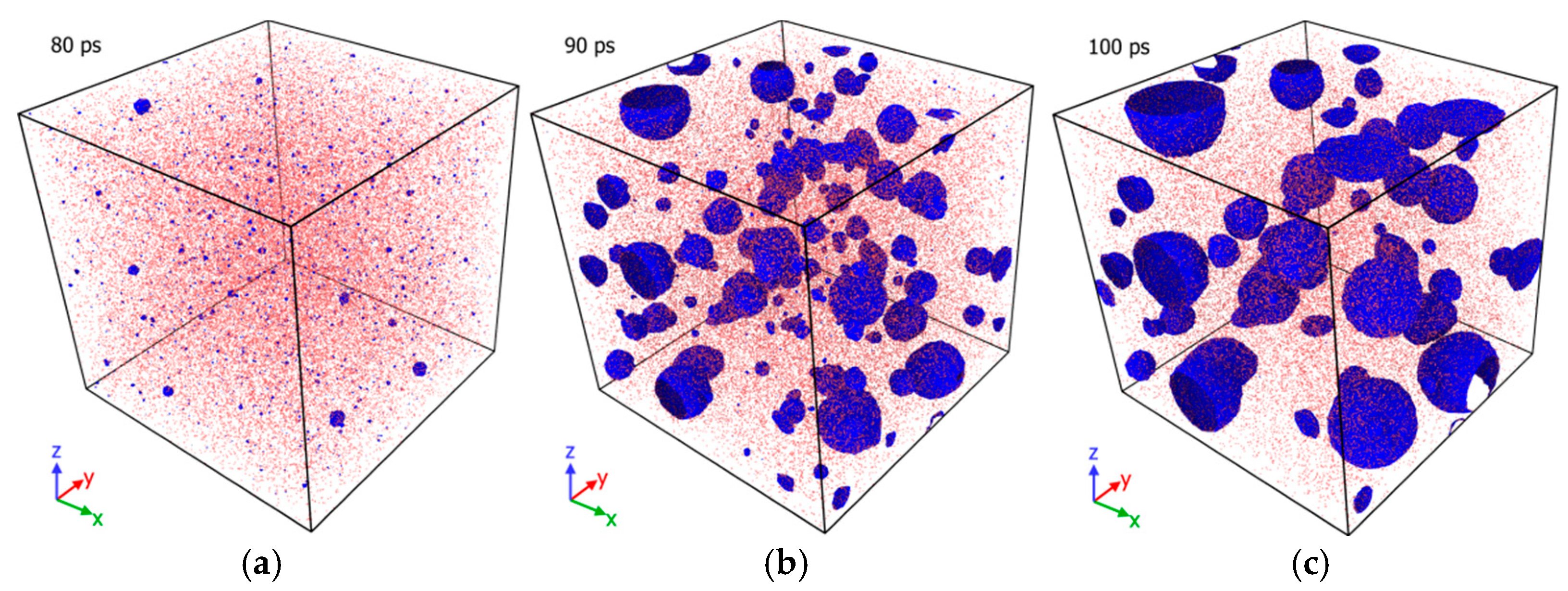
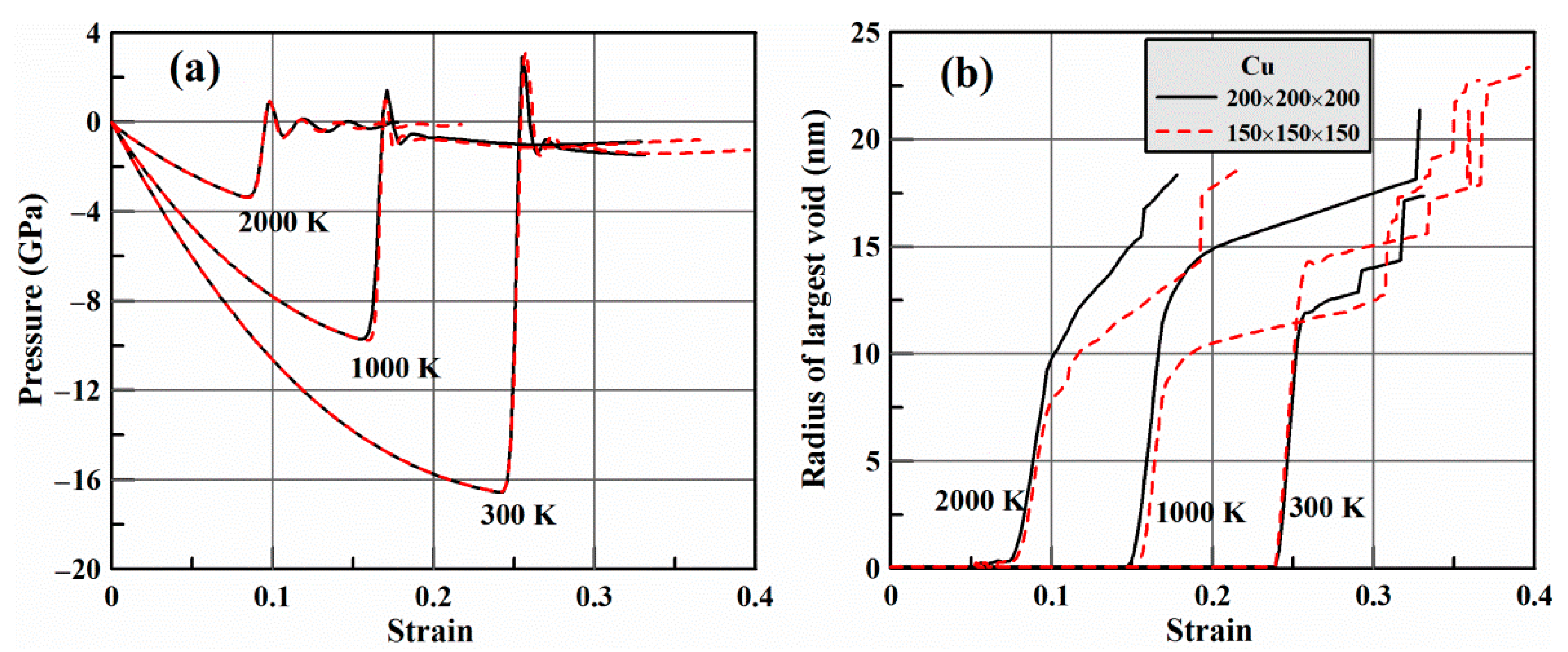

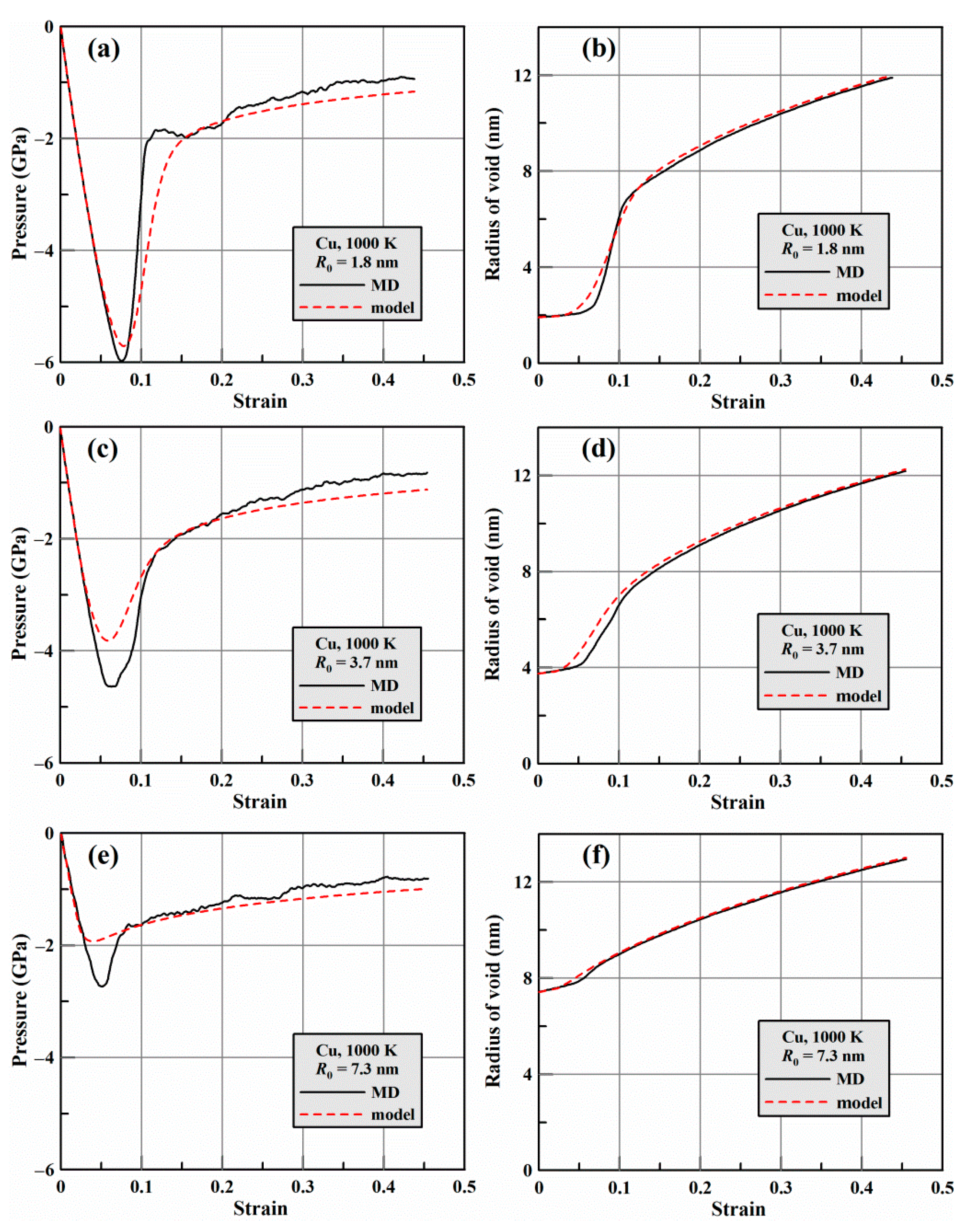
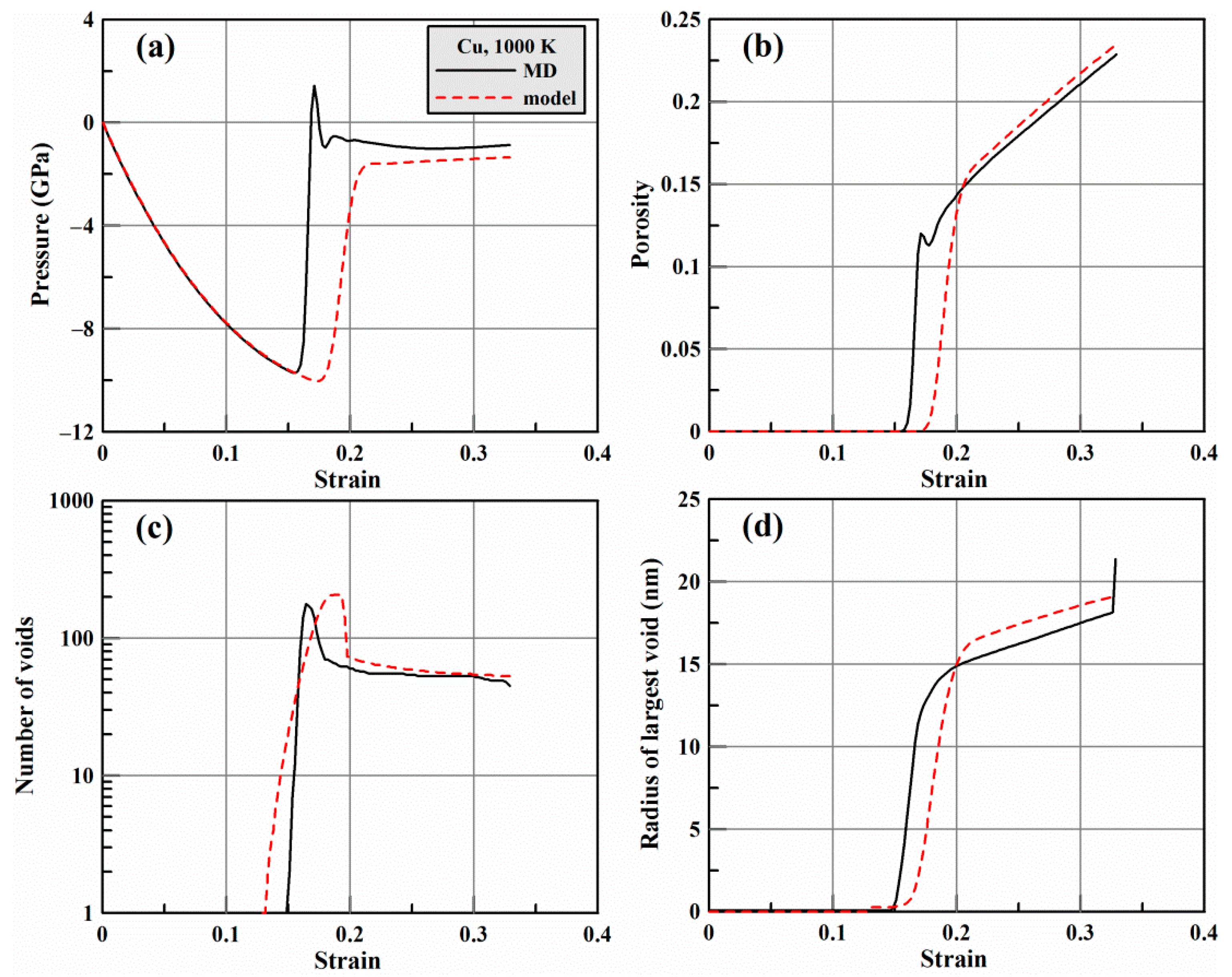

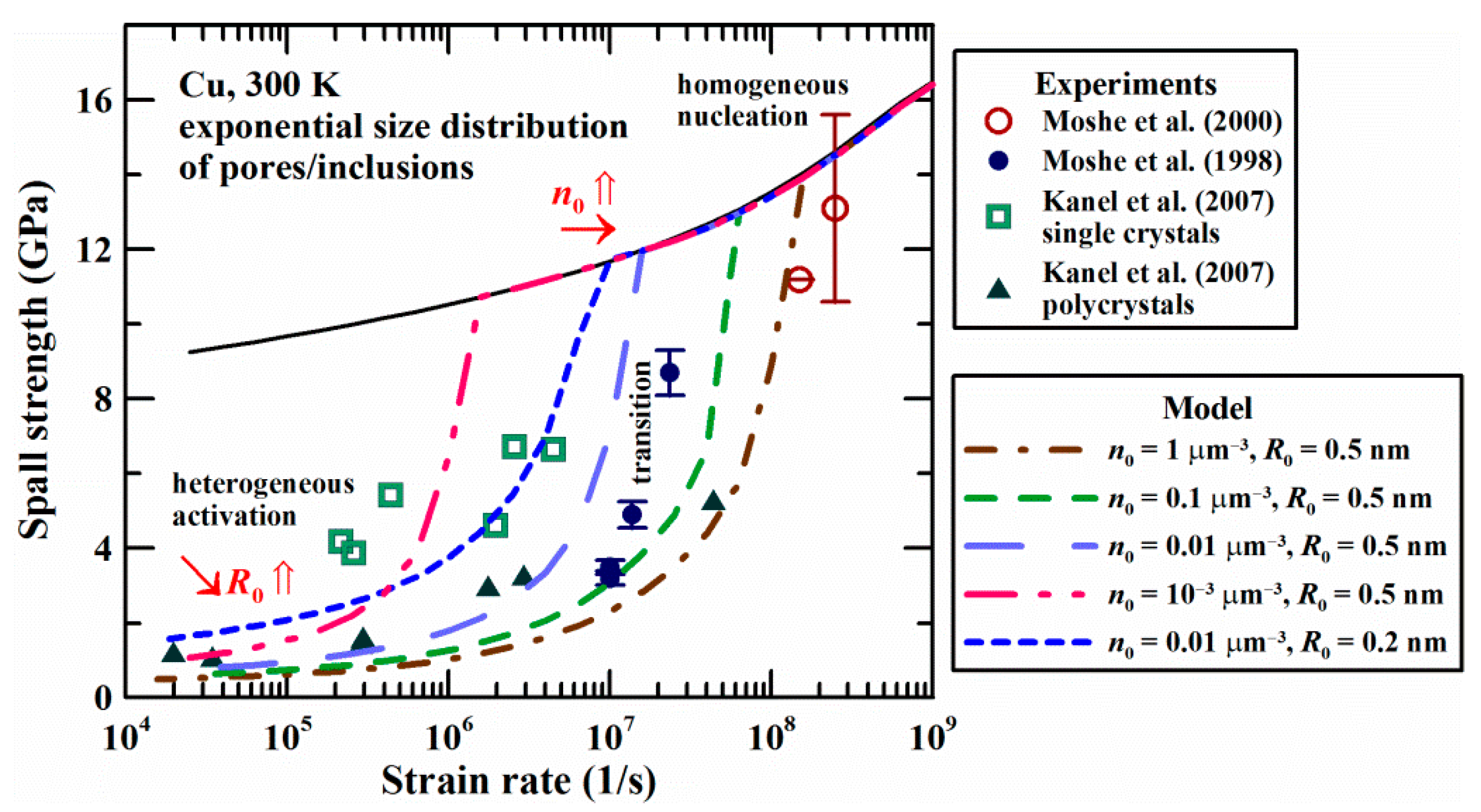


| Temperature | (GPa) | (GPa) | (GPa) | |
|---|---|---|---|---|
| 300 K | 138 | 333 | 192 | 0.337 |
| 1000 K | 110 | 356 | 323 | 0.337 |
| 2000 K | 58 | 256 | 517 | 0 |
| Temperature | (J/m2) | (eV) | (GPa) | (ps) | (Pa × s) |
|---|---|---|---|---|---|
| 300 K | 1.0 | 0.08 | 1.8 | 6 | − |
| 1000 K | 1.1 | 0.08 | 1.8 | 2.7 | − |
| 2000 K | 0.65 | − | − | − | 3⋅10−3 |
Publisher’s Note: MDPI stays neutral with regard to jurisdictional claims in published maps and institutional affiliations. |
© 2022 by the authors. Licensee MDPI, Basel, Switzerland. This article is an open access article distributed under the terms and conditions of the Creative Commons Attribution (CC BY) license (https://creativecommons.org/licenses/by/4.0/).
Share and Cite
Mayer, P.N.; Pogorelko, V.V.; Voronin, D.S.; Mayer, A.E. Spall Fracture of Solid and Molten Copper: Molecular Dynamics, Mechanical Model and Strain Rate Dependence. Metals 2022, 12, 1878. https://doi.org/10.3390/met12111878
Mayer PN, Pogorelko VV, Voronin DS, Mayer AE. Spall Fracture of Solid and Molten Copper: Molecular Dynamics, Mechanical Model and Strain Rate Dependence. Metals. 2022; 12(11):1878. https://doi.org/10.3390/met12111878
Chicago/Turabian StyleMayer, Polina N., Victor V. Pogorelko, Dmitry S. Voronin, and Alexander E. Mayer. 2022. "Spall Fracture of Solid and Molten Copper: Molecular Dynamics, Mechanical Model and Strain Rate Dependence" Metals 12, no. 11: 1878. https://doi.org/10.3390/met12111878





